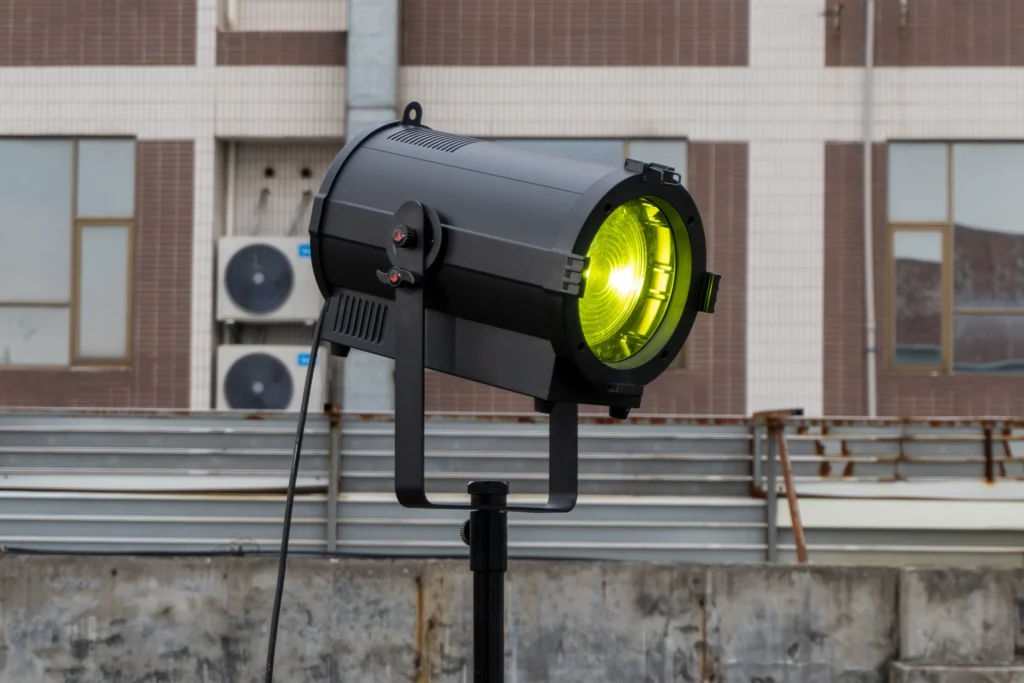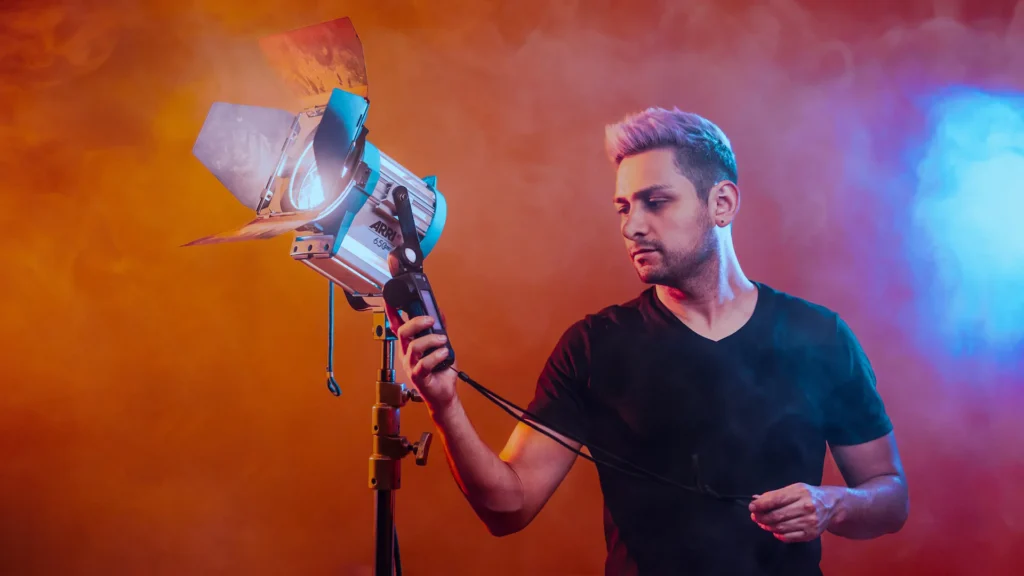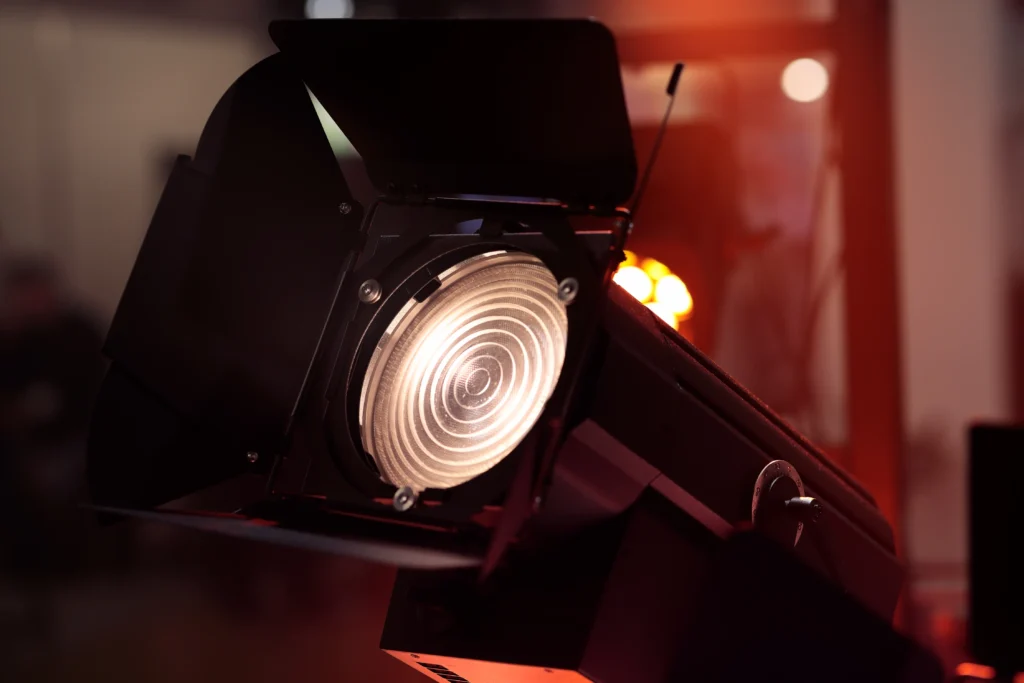Fresnel lights are a popular type of lighting fixture used in the film, television and photography industries. They are named after Augustin-Jean Fresnel, the French physicist who first developed the lens system that is used in these lights.
What is fresnel light?

So what exactly is a fresnel light? In simple terms, it is a spotlight that uses a Fresnel lens to focus and direct the light in a specific direction. The lens consists of concentric rings that create a stepped surface. This design allows for greater control over the direction and intensity of the light produced by the fixture.
Fresnel lights are known for their unique qualities, which make them particularly useful for certain types of filming and photography. One of the main advantages of Fresnel lights is their ability to produce a hard-edged beam of light that can be precisely directed onto a subject or area of interest. This makes them ideal for creating dramatic shadows and highlights, as well as for accentuating textures and details in a scene.
Another benefit of Fresnel lights is that they are very efficient when it comes to producing high-quality light output. The Fresnel lens captures and focuses more light than a traditional lens, which means that less energy is needed to produce the same level of illumination. This makes them ideal for use in situations where power consumption is a concern or where a large number of lights are needed.
Additionally, many Fresnel lights feature adjustable lenses that allow for fine-tuning of the focus and spread of the light. This means that they can be easily adapted to suit different shooting conditions and environments.
Fresnel lights are available in a variety of sizes and configurations, ranging from small, compact units to large studio fixtures. They can be powered by a range of sources, including mains electricity, batteries or generators, and can produce a wide range of color temperatures, from warm tungsten to cool daylight.
Application of fresnel light
How is fresnel light used?
Fresnel lights are typically used as key lights, fill lights, and backlights in productions. They are known for their ability to create a soft, diffused light that can be easily directed to specific areas of the stage or set. The lens of the Fresnel light can be adjusted to create a narrow or wide beam of light, making it ideal for creating dramatic effects or highlighting specific areas of the set.
Where is fresnel light used?
Fresnel lights are widely used in a variety of applications, including film and television production, photography, theater production, live events, and architectural lighting. They are particularly well-suited to creating dramatic and precise lighting effects.
Types of fresnel lights

There are several types of Fresnel lights available, each with its own unique features and benefits. Some of the most common types include:
- Tungsten fresnel lights: These use traditional tungsten filament bulbs, which produce warm, yellowish light.
- LED fresnel lights: These use energy-efficient LEDs to produce a wide range of color temperatures and can be dimmed without changing the color temperature. White LED fresnel light can have optional of different color temperature like 3200K, 4000K, 5600K and even custimized color temperature. Moreover, LED fresnel can offer colored LED like RGBW, RGBAL, RGBALC which can create almost limitless colors.
- HMI fresnel lights: These use metal halide bulbs to produce bright, daylight-balanced light that and super high output is ideal for outdoor shoots.
Difference between HMI fresnel lights and Tungsten fresnel lights
The main difference between HMI Fresnel lights and Tungsten Fresnel lights is the type of bulb they use. HMI lights use a high-intensity discharge (HID) bulb, while Tungsten lights use a filament bulb. This difference in bulb technology leads to several differences in their performance:
- Color temperature: HMI lights have a color temperature of around 5600K, which is similar to daylight. Tungsten lights, on the other hand, have a color temperature of around 3200K, which is similar to incandescent light bulbs.
- Power consumption: HMI lights tend to be more power-efficient than Tungsten lights. This means that they require less power to produce the same amount of light.
- Heat output: Tungsten lights get quite hot during use, which can make them uncomfortable to work with in close quarters. HMI lights generate less heat, making them more comfortable to work with.
- Price: HMI lights tend to be more expensive than Tungsten lights.
These differences mean that HMI fresnel lights are often preferred for outdoor shoots or in situations where a lot of light is needed, while tungsten fresnel lights are often used for indoor shoots where warm lighting is desired, or when a lower-cost option is required.
Advantages of LED fresnel light
LED as the new technology, when it’s applied to fresnel light. There are several advantages compared to HMI and tungsten fresnel lights:
- Energy efficiency: LED fresnel lights use significantly less power compared to HMI and tungsten fresnel lights, which can result in lower electricity bills.
- Heat output: LED fresnel lights produce very little heat compared to HMI and tungsten fresnel lights, making them safer to handle and reducing the need for cooling equipment on set.
- Color accuracy: LED fresnel lights offer excellent color accuracy, with high CRI (Color Rendering Index) values and the ability to adjust color temperature as needed.
- Portability: LED fresnel lights are generally smaller and lighter than HMI and tungsten fresnel lights, making them easier to transport and set up.
- Durability: LED fresnel lights have a longer lifespan compared to HMI and tungsten fresnel lights, with no fragile filaments or bulbs that can break or burn out.
- Flexibility: LED fresnel lights are often more versatile than HMI and tungsten fresnel lights, with the ability to adjust brightness, color temperature, and beam angle using built-in controls or external accessories.
- Safety: Compare to lamp based fresnel, which may produces high heat of surfaces, LED fresnel produces very little heat and is more safe.
Color temperature of LED fresnel light
Fresnel lights are available in a wide range of color temperatures, which refers to the hue or warmth of the light. The most common color temperatures for Fresnel lights are 3200K and 5600K.
- 3200K: This is often referred to as “warm” or “tungsten” light, and has a yellowish-orange hue. It is commonly used in indoor settings and creates a cozy and intimate atmosphere.
- 5600K: This is often referred to as “cool” or “daylight” light, and has a bluish-white hue. It is commonly used in outdoor settings and creates a bright and airy feeling.
Some Fresnel lights also offer adjustable color temperature, which allows you to fine-tune the lighting to match the environment or achieve a specific mood. With adjustable color temperature, you can typically set the light anywhere between 2700K and 6500K.
White color VS colored fresnel light
Fresnel lights are also available in white as well as colored variants.
White Fresnel Lights: White Fresnel lights produce a neutral, daylight-balanced light that is ideal for a wide range of applications. They are commonly used in film and television production, photography, theater production, live events, and architectural lighting.
Colored Fresnel Lights: Colored Fresnel lights produce light in a specific color or hue, rather than a neutral white light. They are commonly used in theatrical productions, concerts, and other events where creative lighting designs are required.
Color filters or gels can be attached to the front of the Fresnel lens to create colored light. These filters are available in a wide range of colors, including blue, green, red, yellow, and purple. By combining different colors and intensities of light, you can achieve a wide range of creative and dramatic lighting effects.
Companies producing fresnel lights
When it comes to fresnel lights manufactures. You’ve got a lot of choices. There are many companies that produce high-quality fresnel lights, including Arri, ETC, ADJ, Chauvet, Highlite, DeSisti, Mole-Richardson and other more which is not listed.
And also Ovation lights, as a professional theatre lights manufacture, besides the profile spot lights, we also developed and manufacture a whole series of LED fresnel lights, with power range from 40Watt, 50Watt to 350Watt. It’s a perfect upgrade of your traditional lamp fresnel to LED. Save energy and same or even more light output.
Difference between fresnel lights and ellipsoidal lights
Fresnel lights and ellipsoidal lights (also known as ERS or Lekos) are both popular types of lighting fixtures used in the film and television industries. While they share some similarities, there are also some key differences between the two.
Fresnel lights produce a soft-edged beam of light that can be focused and directed using a Fresnel lens. They are best suited for creating broad washes of light, as well as for highlighting specific subjects or areas of interest.
Ellipsoidal lights, on the other hand, produce a hard-edged beam of light that can be precisely shaped and focused using various lenses and accessories. They are ideal for creating sharp, well-defined patterns and textures, as well as for projecting images and gobo patterns.
Difference between fresnel lens and PMMA lens
Fresnel lenses and PMMA (Polymethyl Methacrylate) lenses are both types of optical lenses, but they differ in terms of their construction and properties.
Fresnel Lens: A Fresnel lens is a type of flat lens that is made up of a series of concentric rings or ridges on the surface. These rings act as individual prisms and bend the light passing through them, allowing the lens to focus and magnify the light. Fresnel lenses are commonly used in lighthouses, projectors, and other applications where a large and powerful lens is needed.
PMMA Lens: PMMA lenses, on the other hand, are made from a clear plastic material called polymethyl methacrylate. This material is lightweight, durable, and offers excellent optical clarity. PMMA lenses are commonly used in eyeglasses, camera lenses, and other applications where a smaller, more lightweight lens is needed.
One of the main differences between Fresnel lenses and PMMA lenses is the way they bend light. Fresnel lenses use a series of individual prisms to bend the light, while PMMA lenses rely on the shape of the lens itself to bend the light. This means that Fresnel lenses can produce sharper and more precise images over longer distances, while PMMA lenses are better suited for closer-range applications.
What accessories does a fresnel light have?
Fresnel lights have a variety of accessories available that can be used to customize and control the light output. Some common accessories include:
- Barn Doors: These are adjustable flaps that attach to the front of the Fresnel lens and are used to shape and control the direction of the light.
- Diffusion Filters: These are filters that can be attached to the front of the lens to soften the light and create a more diffused, even glow.
- Color Filters/Gels: These are colored filters that can be attached to the front of the lens to create different colored lighting effects.
- Scrims: These are metal screens that can be inserted in front of the lamp to reduce the light output while maintaining the color temperature. They are also used to control the beam intensity or the depth-of-field.
- Gel Frames: These are frames that hold color filters or diffusion filters in place in front of the lens.
- Light Stands: These are stands or tripods that support the Fresnel light and allow it to be positioned at different angles and heights.
- Safety Cables: These cables secure the Fresnel light to the light stand, preventing it from falling or tipping over.
- Barndoors Pouches/Carrying Cases: These are bags or cases specifically designed to protect and transport barn doors when not in use.
By using these accessories along with your fresnel light, you can achieve greater control over the light output, allowing you to create a wider range of lighting effects and moods.
How to choose the right fresnel lights
Choosing the right Fresnel lights depends on a variety of factors, including the specific application, budget, and personal preferences. Some key factors to consider when choosing Fresnel lights include:
- Light Output: Consider the amount of light output you need for your particular application, as well as the color temperature and quality of light.
- Power Source: Decide how you will power your Fresnel lights, whether through mains electricity, batteries, or generators.
- Size and Portability: Consider the size and weight of your Fresnel lights, as well as their portability and ease of use.
- Budget: Determine your budget and choose Fresnel lights that offer the best balance of features and affordability.
- Brand and Reputation: Choose a reputable brand with a proven track record in the industry.
In conclusion, Fresnel lights are versatile and powerful lighting tools that can be used in a variety of applications. By considering the specific needs of your project and choosing the right type of Fresnel light, you can achieve stunning and professional-looking lighting effects.
How to setup fresnel light in a theatre stage?
Setting up Fresnel lights for a theater stage requires careful planning and execution to ensure that the lighting design meets the needs of the performance. Here are some basic steps to help you set up your Fresnel lighting for a theater stage:
- Determine the Lighting Needs: Before setting up your Fresnel lights, determine the lighting needs of the production. This will include factors such as the mood and atmosphere, the focal points of the performance, and any required color or intensity changes during the show.
- Position the Lights: Once you have determined the lighting needs, position the Fresnel lights at appropriate places on the stage. These lights should be placed on lighting stands or rigging, above or slightly to the side of the stage to avoid casting shadows.
- Focus the Lights: Adjust the focus of each Fresnel light to achieve the desired angle and spread of light. Use barn doors or other accessories to control the direction of the light and prevent spill-over onto unwanted areas.
- Add Filters: Depending on the production requirements, add color filters or diffusion gels to the Fresnel lights to create the desired lighting effect. Make sure the filters are secured in place properly.
- Set Intensity Levels: Set the intensity levels of each Fresnel light according to the lighting design plan. Adjust the dimmer switches or control board to achieve the desired brightness for each lighting cue.
- Test the Lighting Design: Before the actual performance, test the lighting design by running through a rehearsal with the actors on stage. Make sure the lighting enhances the performance and facilitates the audience’s attention.
- Adjust as Needed: If necessary, make adjustments to the lighting design during rehearsals or the actual performance to fine-tune the lighting effects.
It is important to note that setting up Fresnel lights on a theater stage can be complex and requires specialized knowledge and experience. It is recommended to consult with lighting professionals or technicians to ensure the best results.
In conclusion, Fresnel lights are a versatile and powerful lighting tool that has become a staple in the theatre, film, television and photography industries. With their unique lens system and precise control over light output, they are ideal for creating dramatic visual effects and capturing stunning imagery. While they may be more costly than other types of lighting fixtures, their many benefits make them a worthwhile investment for professionals looking to capture high-quality visuals.

